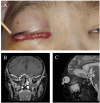Rhino-orbito-cerebral mucormycosis after allogeneic hematopoietic stem cell transplantation for very severe aplastic anemia in a child: a case report
- PMID: 40297559
- PMCID: PMC12034642
- DOI: 10.3389/fped.2025.1529656
Rhino-orbito-cerebral mucormycosis after allogeneic hematopoietic stem cell transplantation for very severe aplastic anemia in a child: a case report
Abstract
Rhino-orbito-cerebral mucormycosis (ROCM) is a rare and life-threatening fungal infection that predominantly affects immunocompromised individuals, such as those undergoing hematopoietic stem cell transplantation (HSCT). This report describes the case of a 10-year-old girl with very severe aplastic anemia (VSAA) who underwent an haploidentical HSCT from her father. She initially achieved successful engraftment with a donor chimerism rate of 98.25% on day 60. However, on day 65 post-transplant, she developed severe right-eye pain, progressive swelling, and visual impairment. Comprehensive evaluations, including contrast-enhanced magnetic resonance imaging (MRI) and cerebrospinal fluid (CSF) analysis, revealed extensive orbital and cerebral involvement consistent with ROCM. Intensive antifungal therapy with liposomal amphotericin B and posaconazole, along with endoscopic surgical debridement of the infected sinuses and orbital regions, was initiated. Post-treatment MRI scans demonstrated a significant reduction in cerebral edema and other abnormalities, while repeated CSF analyses confirmed the absence of fungal elements. This case underscores the critical need for early diagnosis and aggressive management of ROCM in immunocompromised patients, particularly following HSCT.
Keywords: antifungal therapy; hematopoietic stem cell transplantation; rhino-orbito-cerebral mucormycosis; surgical intervention; very severe aplastic anemia.
© 2025 Ma, Xia, Cheng, Wang, Huang and Lu.
Conflict of interest statement
The authors declare that the research was conducted in the absence of any commercial or financial relationships that could be construed as a potential conflict of interest.
Figures



Similar articles
-
Rhino-Orbital Cerebral Mucormycosis in a Healthy Female Child: Case Report.Int Med Case Rep J. 2024 Mar 26;17:241-246. doi: 10.2147/IMCRJ.S454697. eCollection 2024. Int Med Case Rep J. 2024. PMID: 38559497 Free PMC article.
-
Combination antifungal therapy without craniotomy in an immunocompromised patient with rhino-orbito-cerebral mucormycosis: A case report.Caspian J Intern Med. 2020;11(2):227-230. doi: 10.22088/cjim.11.2.227. Caspian J Intern Med. 2020. PMID: 32509254 Free PMC article.
-
Fungal Endophthalmitis in a Case of Rhino-Orbito-Cerebral Mucormycosis: Successfully Treated With Amphotericin B Colloidal Dispersion.Front Microbiol. 2022 Jun 15;13:910419. doi: 10.3389/fmicb.2022.910419. eCollection 2022. Front Microbiol. 2022. PMID: 35783387 Free PMC article.
-
Various Treatment Modalities in COVID-19 Associated Facial Mucormycosis and the Need for its Surgical Management: A Systematic Review.J Maxillofac Oral Surg. 2023 Mar 13:1-22. doi: 10.1007/s12663-023-01878-8. Online ahead of print. J Maxillofac Oral Surg. 2023. PMID: 37362874 Free PMC article. Review.
-
COVID-19-associated rhino-orbital-cerebral mucormycosis: A systematic review, meta-analysis, and meta-regression analysis.Indian J Pharmacol. 2021 Nov-Dec;53(6):499-510. doi: 10.4103/ijp.ijp_839_21. Indian J Pharmacol. 2021. PMID: 34975140 Free PMC article.
References
Publication types
LinkOut - more resources
Full Text Sources

